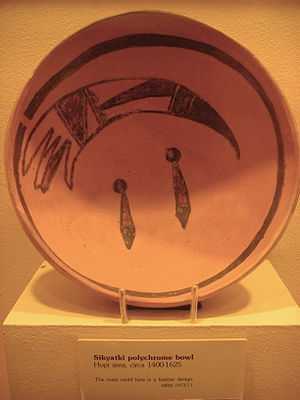Millicent Rogers

_-_Henri_de_Toulouse-Lautrec.jpg)
Mary Millicent Abigail Rogers (February 1, 1902 - January 1, 1953), better known as Millicent Rogers, was a socialite, fashion icon, and art collector. She was the granddaughter of Standard Oil tycoon Henry Huttleston Rogers, and an heiress to his wealth.[1]
Rogers is notable for having been an early supporter and enthusiast of Southwestern-style art and jewelry,[1] and is often credited for its reaching a national and international audience. Later in life, she became an activist, and was among the first celebrities to champion the cause of Native American civil rights. She is still credited today as an influence on major fashion designers.
Biography
Rogers was born February 1, 1902. Her mother was Mary B. Rogers and her father was Henry Huttleston Rogers II, whose father founded the Standard Oil fortune.[2] She grew up in Manhattan, Tuxedo Park, and Southampton, New York.[2]
When Millicent contracted rheumatic fever as a young child, doctors predicted she would not live past the age of 10.[1] She suffered from poor health for the rest of her life, having multiple heart attacks, bouts with double pneumonia, and a mostly crippled left arm by the time she was 40 years old.[1]
In the 1920s, as a young woman Rogers became well-known on the socialite scene, and photographs of her were often featured in Vogue and Harper's Bazaar.[3] Newspaper gossip columns, such as the one in the Hearst's New York Journal-American, regularly detailed her personal life. Rogers lived primarily as an expatriate for many years, and remained in Switzerland until World War II broke out.[1]
In the mid-1940s, Rogers retreated to a small adobe home in Taos, New Mexico, which she referred to as Turtle Walk. While living there, she purchased more than 2,000 Native American artifacts.[1] In 1947, Rogers and several prominent friends (including authors Frank Waters, Oliver Lafarge and Lucius Beebe) hired lawyers and visited Washington, D.C. to promote the issue of Indian rights and citizenship.[4] She successfully lobbied for Native American art to be classified as historic, and therefore protected.[4]
She died in January 1953, following surgery for an aneurysm. Her autopsy revealed that her heart had swollen to four times the normal size.[1] Her legal full name at her time of death was Mary Millicent Abigail Rogers von Salm-Hoogstraeten de Peralta-Ramos Balcom.[1]
Marriage and family
Rogers was married three times during the course of her life. Her first marriage was in January 1924, when she eloped with Austrian Ludwig von Salm-Hoogstraeten and married in a New York courtroom; she was 20 years old and the groom was 40. An unemployed film actor through most of their short marriage, Salm-Hoogstraten was characterized by The New York Times as "a gold-digging Austrian count"[2][5] and Time called him "penniless."[6] The couple had one son together, Peter Salm, but had legally separated before the boy was born.[7][8] Their divorce was finalized in April 1927.[9]
On November 8, 1927, she married Arturo Peralta-Ramos, "a wealthy Argentine."[10] The couple had two children together, Paul Jaime and Arturo Henry Peralta-Ramos Jr.[11] They were married in the parish house of the Roman Catholic Church of the Sacred Heart of Jesus and Mary in Southampton, Long Island, with only Roger's father and a few friends in attendance.[10] Approving of the marriage, Henry Huddleston Rogers II gave the couple a $500,000 trust fund, with the provision that Peralta-Ramos "lay no future claim to the Rogers fortune, estimated at $40,000,000."[10] Peralta-Ramos filed for divorce on December 6, 1935, with both parties citing "extreme cruelty".[6][11]
Rogers' third and final husband was Ronald Balcom, an American stockbroker. They were married in Vienna on February 26, 1936,[12] and were divorced in February 1941.[6][13] They had no children together.
Millicent Rogers was romantically linked to a number of notable men throughout her life, including author Roald Dahl, actor Clark Gable, the author Ian Fleming, the Prince of Wales, Prince Serge Obolensky, and an unknown "heir to the Italian throne".[2][1][14]
Legacy
Millicent Rogers Museum
In 1956, the Rogers family founded the Millicent Rogers Museum in Taos, New Mexico.[15] The museum houses a large collection of Native American, Hispanic, and Euro-American art, with a specific emphasis on northern New Mexico and Taos pieces.[15] It first opened in a temporary location in the mid-1950s, later moving to its permanent location in the late 1960s, a home built by Claude J. K. and Elizabeth Anderson.[15] It was later remodeled and expanded by architect Nathaniel A. Owings.[15]
Fashion
Fashion designer John Galliano credited Millicent Rogers as an influence on his Spring 2010 Dior collection.[2][16]
References
- ↑ 1.0 1.1 1.2 1.3 1.4 1.5 1.6 1.7 1.8 Owens, Mitchell (August 19, 2001). "Desert Flower". The New York Times.
- ↑ 2.0 2.1 2.2 2.3 2.4 Petkanas, Christopher (March 16, 2010). "Fabulous Dead People: Millicent Rogers". The New York Times.
- ↑ "Beauty and the Best: Millicent Rogers Museum". The Collector’s Guide to Santa Fe and Taos 10.
- ↑ 4.0 4.1 New Mexico Tourism Department official website article: "Millicent Rogers."
- ↑ The Telegraph Herald article: "Count Was Broke During Honeymoon."
- ↑ 6.0 6.1 6.2 Time article: "Milestones, Jan. 12, 1953."
- ↑ South Coast Today article: "Mary Millicent Rogers had rich, colorful life."
- ↑ Princeton Alumni Weekly article: "Peter A. Salm '50."
- ↑ The Milwaukee Journal article: "Millicent Rogers Granted Divorce."
- ↑ 10.0 10.1 10.2 The Sunday Vindicator article: "Millicent Rogers Embarks Again upon Matrimonial Sea."
- ↑ 11.0 11.1 The Youngstown Vindicator article: "Millicent Rogers sued for divorce."
- ↑ Baltimore Sun article: "Standard Oil Heiress Married Third Time."
- ↑ The Miami News article: "Millicent Rogers Sued For Divorce."
- ↑ The Times article: "Socks away! Roald Dahl’s wartime sex raids."
- ↑ 15.0 15.1 15.2 15.3 Millicent Rogers Museum official website: "Museum info."
- ↑ The New York Times article: "In Paris, Tempted by History."
External links
- Official website of The Millicent Rogers Museum
- Essay on Millicent Rogers by Jill Hoffrman, former MRM director
- Millicent Rogers at Find A Grave
- "Thoroughly Marvelous Millie" by Cherie Burns, WSJ, September 17, 2011
